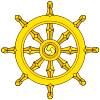Buddhist

The Life of Buddha
The history of Buddhism is the story of one man’s spiritual journey to Enlightenment, and of the teachings and ways of living that developed from it. Siddhartha Gautama – The Buddha. By finding the path to Enlightenment, Siddhartha was led from the pain of suffering and rebirth towards the path of Enlightenment and became known as the Buddha or ‘awakened one.’
 The Buddhist Churches of America or American Buddhist Church(es) (米国仏教団 or 美国仏教団 Beikoku Bukkyōdan or Bikoku Bukkyōdan?) is the United States branch of the Honpa Hongan-ji (also known as Nishi-Honganji) sub-sect of Jōdo Shinshū (“True Pure Land School”) Buddhism. Jodo Shinshu is also popularly known as Shin Buddhism. The B.C.A. is one of several overseaskyodan (“districts”) belonging to the Nishi (“Western”) Hongwan-ji. The other kyodan are South America, Hawaiʻi, Jodo Shinshu Buddhist Temples of Canada, and Europe. Their headquarters is at 1710 Octavia Street, San Francisco, California, near San Francisco’s Japantown. It is the second oldest Buddhist organization in the United States.
The Buddhist Churches of America or American Buddhist Church(es) (米国仏教団 or 美国仏教団 Beikoku Bukkyōdan or Bikoku Bukkyōdan?) is the United States branch of the Honpa Hongan-ji (also known as Nishi-Honganji) sub-sect of Jōdo Shinshū (“True Pure Land School”) Buddhism. Jodo Shinshu is also popularly known as Shin Buddhism. The B.C.A. is one of several overseaskyodan (“districts”) belonging to the Nishi (“Western”) Hongwan-ji. The other kyodan are South America, Hawaiʻi, Jodo Shinshu Buddhist Temples of Canada, and Europe. Their headquarters is at 1710 Octavia Street, San Francisco, California, near San Francisco’s Japantown. It is the second oldest Buddhist organization in the United States.
Origins and Development
The origins of the Buddhist Churches of America(BCA) or American Buddhist Churches(ABC) began with the arrival of Japanese immigrants to the American mainland during the late 1800s. Devout Shin Buddhists who had expressed concern over the lack of religious services, and the activities of Christian missionaries among the newly arrived immigrant population, petitioned the monshu(head abbot) of the Nishi Hongwan-ji to send priests to the United States. The first Jodo Shinshu priests arrived in San Francisco in 1893, and the first American temple constructed in 1899. The priests’ arrival in San Francisco was a source of concern to the Japanese consul to the U.S. who believed it would strain U.S.-Japan relations: for example, a hostile article by the San Francisco Chronicle newspaper on the arrival of the priests alleged that the priests’ intent was to convert white Americans and proclaim that Buddhism was superior to Christianity. In the decades prior to World War II, the mainland American branch of the Nishi Hongwan-ji tradition was named the “Buddhist Missions of North America” (BMNA), and many temples were established throughout the West Coast of the United States, the first being in San Francisco, followed by temples in the Bay Area, the Central Valley, and Northern and Southern California. There were also temples established in the Northwest states, in Seattle, Washington and Oregon. Since the majority of early Japanese immigrants or issei (“First Generation”) were farmers or laborers, many of these temples were built in then-rural, and segregated, areas such as Dinuba, Guadalupe, and Sacramento, California.
An earlier separate branch of the Nishi Hongwanji-ha was established on the Hawaiian Islands in the 1880s when it was the Kingdom of Hawaii, the Honpa Hongwanji Mission of Hawaii. Many Japanese had also immigrated to Hawaii to work on the plantations there.
The activities of the BMNA focused solely on the Japanese immigrant community and their families. Priests were expected to conduct funeral and memorial services, teach Buddhism together with traditional Japanese culture, and also to serve as role models for young Japanese men, as at the time they were often considered the most educated Japanese immigrants. Many of these priests only stayed temporarily in the United States, then returned to Japan after serving for a period of a few years; others stayed on in the U.S. temples (a trend that continues today among many priests who are Japanese nationals). Worship services were in the Japanese language, and Japanese-language and English-language schools were common at many temples. Auxiliary temple organizations such as the Young Buddhist Association (YBA) and Buddhist Women’s Association (BWA), common in Japan, were also established in America to enhance the feeling of sangha and ethnic solidarity. Many temples also emphasized American civic principles: Boy Scoutchapters were active in temples before and after World War II. The desire to assimilate into mainstream American society created changes in traditional Japanese Buddhist religious architecture and ritual and culture in order to conform to the predominant Protestant Christian religion: temples resembled Christian churches in their interior style and design (replacing tatami mats with pews and introducing lecterns), and supplemented traditional Shinshu liturgy with introduction of Western musical instruments (organs and pianos) in services, singing of gathas modeled after Christian hymns, and male and female choirs. These changes remain today and are considered the norm for American Jodo Shinshu temples.
Although the focus of temple life emphasized Japanese Buddhism and Japanese culture, there was a very limited outreach to non-Japanese Americans who were interested in Buddhism. A few Caucasian (hakujin) members were admitted into BMNA temples, and a notable few, such as the Rev. Sunya Pratt of Tacoma, Washington, and Rev. Julius Goldwater (a relative of Senator Barry Goldwater) from Los Angeles, even became ordained in the Shin tradition in the U.S. prior to World War II. In 2006, Dr. Gordon Bermant, from Ekoji Buddhist Temple, became the President of the Buddhist Churches of America, the first non-Japanese-American to hold this position.

